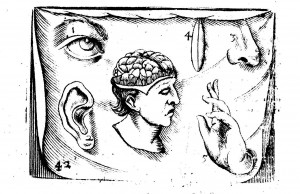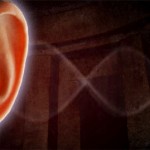Comenius’ Orbis Pictus (1658)
The Skin of the Senses
This representation of the senses comes from the Orbis Sensualium Pictus by the Czech
educator John Amos Comenius. This first ever picture book for children (it contains 150
chapters and covers a wide array of topics, from the senses to the stars) was initially
published in Latin and German in Nuremburg in 1658, and came out in English
translation the year following. The representation is of interest for the way in which the
senses are depicted as specializations of the skin, or extensions of the sense of touch,
which in a sense they are: “Touch is the parent of our eyes, ears, nose, and mouth. It is
the sense which became differentiated into the others, a fact that seems to he recognized
in the age-old evaluation of touch as ‘the mother of the senses” (according to Ashley
Montagu in Touching: The Human Significance of the Skin) or, as in this representation,
their all being folds of the same sheet or cloth. The commentary (see below) is of interest
for the way in which it takes up the medieval classification of the senses into “outward”
and “inward,” with vision, hearing, smell, taste and the hand (in that order) belonging to
the former category and “the common sense” (sensus communis – not to be confused with
common sense), fantasy (or imagination) and memory belonging to the latter category.
Ch. XLII
The outward and
inward Senses.
There are five
outward Senses;
The Eye 1.
seeth colours,
what is white or black,
green or blew
red or yellow.
The Ear 2.
heareth Sounds,
both natural,
voices and Words,
and artificial, musical Tunes.
The Nose 3.
senteth smells
and stinks.
The Tongue 4.
with the roof of the mouth
tasteth savours, what is
sweet or bitter, keen or biting,
sour or harsh.
The Hand 5.
by touching discerneth
the quantity
and quality of things,
the hot and cold,
the moist and dry,
the hard and soft,
the smooth and rough,
the heavy and light.
The inward Senses
are three.
The Common-sense 7.
under the forepart of the head,
apprehendeth
things taken from the
outward Senses
The Phantasie 6.
under the crown of the head
judgeth of those things,
Thinketh and dreameth.
The Memory 8.
Under the hinder part of the head
Layeth up every thing
And fetcheth them out
It loseth some, and this is forgetfulness.
Sleep
is the Rest of the Senses
Imagine thinking of memory — or the imagination (phantasie), for that matter – as a
sensory faculty, a continuation of perceiving! Today it would be considered a cognitive
faculty: the precession of cognition and the recession of perception and the senses is one
of the marks of modern psychology.
David Howes, Concordia University


